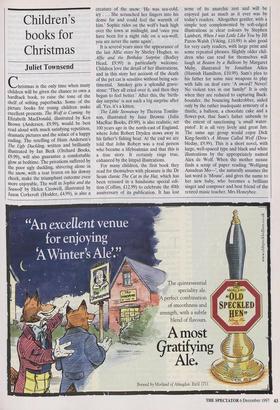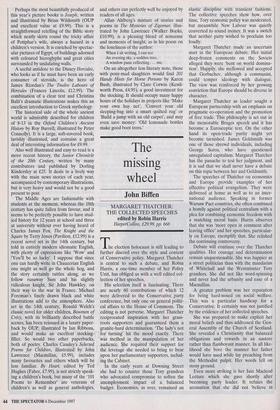Children's books for Christmas
Juliet Townsend
Christmas is the only time when many children will be given the chance to own a hardback book, to raise the tone of the shelf of wilting paperbacks. Some of the picture books for young children make excellent presents. The Wolf is Coming by Elizabeth MacDonald, illustrated by Ken Brown (Andersen, £9.99), would be best read aloud with much satisfying repetition, dramatic pictures and the solace of a happy ending. The retelling of Hans Andersen's The Ugly Duckling, written and brilliantly illustrated by Ian Beck (Orchard Books, £9.99), will also guarantee a comfortable glow at bedtime. The privations suffered by the poor ugly duckling, shivering alone in the snow, with a tear frozen on his downy cheek, make the triumphant outcome even more enjoyable. The wolf in Sophie and the Seawolf by Helen Creswell, illustrated by Jason Corkcroft (Hodder, £4.99), is also a creature of the snow: 'He was sea-cold, icy . . . She scrunched her fingers into his dense fur and could feel the warmth of him.' Sophie rides on the wolfs back high over the town at midnight, and 'once you have been for a night ride on a sea-wolf, you are never the same again'.
It is several years since the appearance of the last Alfie story by Shirley Hughes, so Alfie and the Birthday Surprise (Bodley Head, £9.99) is particularly welcome. Children love the detail of her illustrations, and in this story her account of the death of the pet cat is sensitive without being sen- timental. Smokey gets a splendid grave- stone: 'They all cried over it, and then they began to feel better.' After this, the 'birth- day surprise' is not such a big surprise after all. Yes, it's a kitten.
The Little Stowaway by Theresa Tomlin- son, illustrated by Jane Browne (Julia MacRae Books, £9.99), is also realistic, set 100 years ago in the north-east of England, where John Robert Dryden stows away in his father's fishing boat. At the end we are told that John Robert was a real person who became a lifeboatman and that this is a true story. It certainly rings true, enhanced by the limpid illustrations.
For many children, the first book they read for themselves with pleasure is the Dr Seuss classic The Cat in the Hat, which has been reissued in a handsome special edi- tion (Collins, £12.99) to celebrate the 40th anniversary of its publication. It has lost none of its anarchic zest and will be enjoyed just as much as it ever was by today's readers. Altogether gentler, with a simple text complemented by soft-edged illustrations in clear colours by Stephen Lambert, When I was Little Like You by Jill Paton-Walsh (Viking, £10.99) is also good for very early readers, with large print and some repeated phrases. Slightly older chil- dren who can read for themselves will laugh at Beaten by a Balloon by Margaret Mahy, illustrated by Jonathan Allen (Hamish Hamilton, £10.99). Sam's plea to his father for some nice weapons to play with falls on deaf ears: 'A sword? Never! No violent toys in our family!' It is only when they are reduced to capturing Buck- bounder, the bouncing bankrobber, aided only by the rather inadequate armoury of a thistle, a balloon, a chocolate cake and a flower-pot, that Sam's father unbends to the extent of sanctioning 'a small water- pistol'. It is all very lively and great fun. The same age group would enjoy Dick King-Smith's A Mouse Called Wolf (Dou- bleday, £9.99). This is a short novel, with large, well-spaced type and black and white illustrations by the appropriately named Alex de Wolf. When the mother mouse finds a scrap of paper reading 'Wolfgang Amadeus Mo—', she naturally assumes the last word is 'Mouse', and gives the name to her new baby, who becomes a brilliant singer and composer and best friend of the retired music teacher, Mrs Honeybee. Perhaps the most beautifully produced of this year's picture books is Joseph, written and illustrated by Brian Wildsmith (OUP and excellent value at £9.99). This is a straightforward retelling of the Bible story which neatly skirts round the tricky affair of Potiphar's wife, always a hazard in a children's version. It is enriched by spectac- ular pictures of Egypt, of buildings adorned with coloured hieroglyphs and great cities surrounded by undulating walls.
A useful antidote to the Disney Hercules, who looks as if he must have been an early consumer of steroids, is the hero of James Riordan's The Twelve Labours of Hercules (Frances Lincoln, £12.99). The combination of a clear text and Christina Balit's dramatic illustrations makes this an excellent introduction to Greek mythology.
The historical side of the whole ancient world is admirably described for children of 8-13 in the Oxford Children's Ancient History by Roy Burrell, illustrated by Peter Connolly). It is a large, soft-covered book, lavishly illustrated, and contains a great deal of interesting information for £9.99.
Also well illustrated and easy to read is a more recent history, the Junior Chronicle of the 20th Century, written by many contributors and published by Dorling Kindersley at £25. It deals in a lively way with the main news stories of each year, accompanied by contemporary illustrations, but is very heavy and would not be a good present to post.
The Middle Ages are fashionable with students at the moment, whereas the 18th century has quite fallen from favour, and it seems to be perfectly possible to have stud- ied history for 12 years at school and three at university without ever having heard of Charles James Fox. The Knight and the Squire by Terry Jones (Pavilion, £12.99) is a recent novel set in the 14th century, but told in entirely modern idiomatic English, with plenty of expressions like 'Wow' and `You'll be so lucky'. I suppose that since one can hardly write in Chaucerian English one might as well go the whole hog, and the story certainly rattles along, as we follow runaway Sam and his slightly ridiculous knight, Sir John Hawkley, on their way to the war in France. Michael Foreman's finely drawn black and white illustrations add to the atmosphere. Also set in the 14th century, Ronald Welch's classic novel for older children, Bowmen of Crecy, with its brilliantly described battle scenes, has been reissued in a luxury paper- back by OUP, illustrated by Ian Ribbons, and would make an excellent stocking- filler. So would two other paperbacks, both of poetry. Charles Causley's Selected Poems for Children, illustrated by John Lawrence (Macmillan, £5.99), includes many favourites and others which will be less familiar. By Heart, edited by Ted Hughes (Faber, £7.99), is not strictly speak- ing a children's book, but many of the '101 Poems to Remember' are veterans of children's as well as general anthologies, and others can perfectly well be enjoyed by readers of all ages.
Allan Ahlberg's mixture of stories and poems in The Mysteries of Zigomar, illus- trated by John Lawrence (Walker Books, £10.99), is a pleasing blend of nonsense and moments of insight, as in his poem on the loneliness of the author: When I sit writing, I can see
An evening sky, a sodden tree, A window pane reflecting . . . me.
On an altogether less literary note, those with pony-mad daughters would find 201 Handy Hints for Horse Persons by Karen Bush, illustrated by Clare Corwin (Kenil- worth Press, £4.95), a good investment for the stocking. It should occupy many happy hours of the holidays in projects like 'Make your own hay net', 'Convert your old sleeping-bag into a smart quilted rug' or `Build a jump with an old carpet', and may even save money: 'Old lemonade bottles make good boot trees.'



















































































 Previous page
Previous page